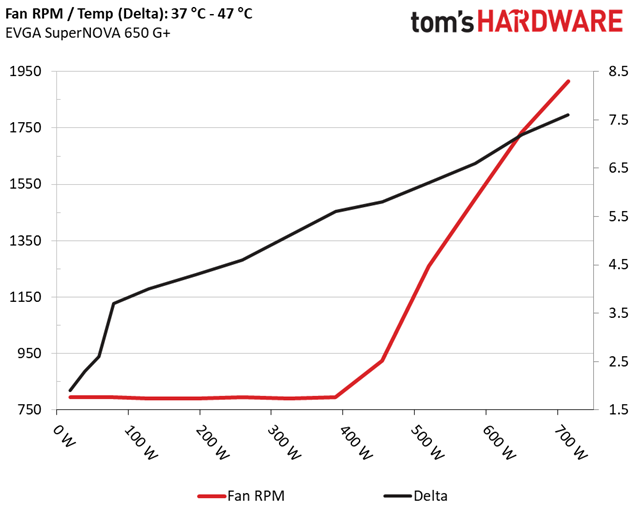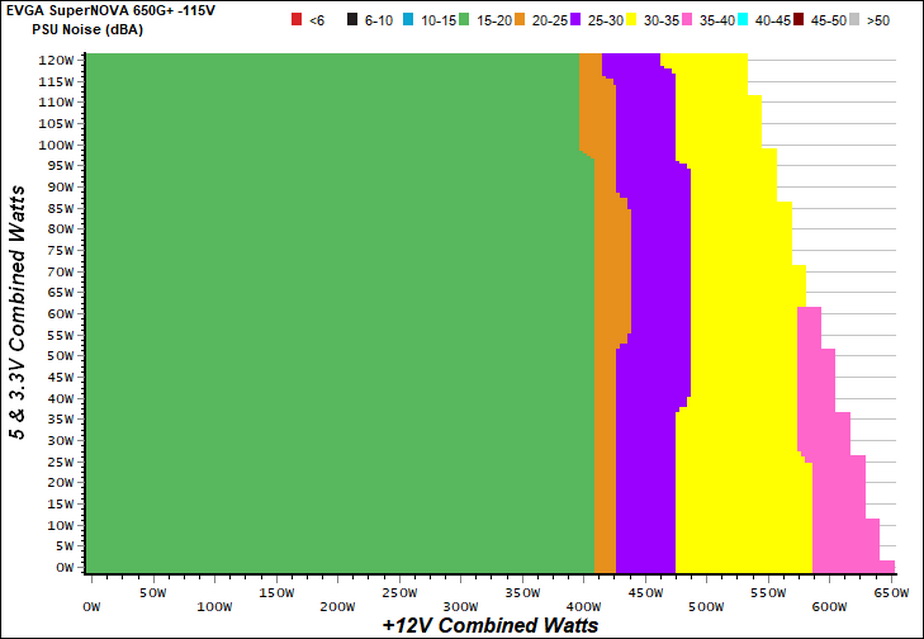EVGA SuperNOVA 650 G1+ PSU Review: Efficient & Silent
Why you can trust Tom's Hardware
Efficiency, Temperature & Noise
Efficiency
Our efficiency testing procedure is detailed here.
Using results from the previous page, we plotted a chart showing the 650 G1+’s efficiency at low loads, and loads from 10 to 110 percent of its maximum-rated capacity.
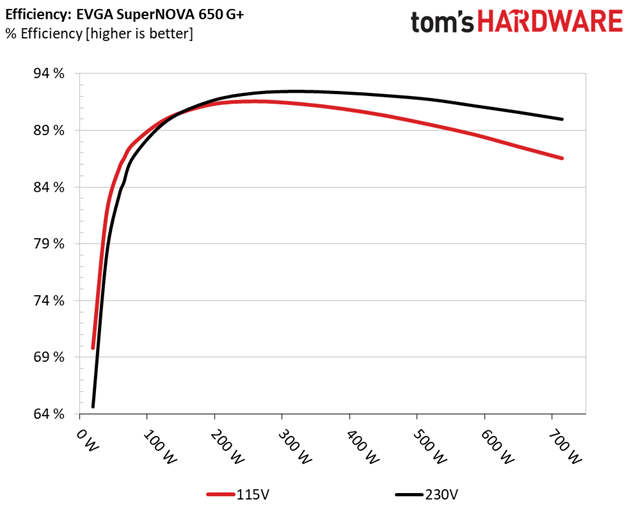
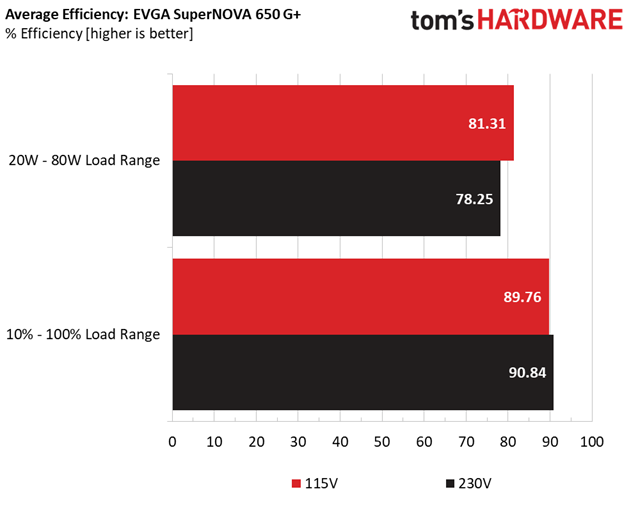
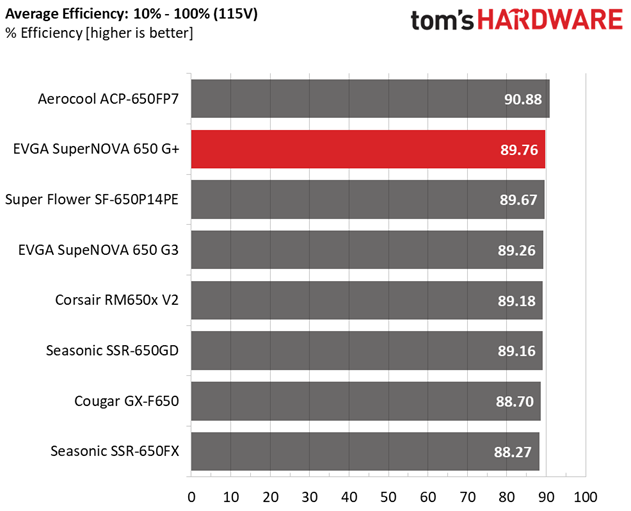
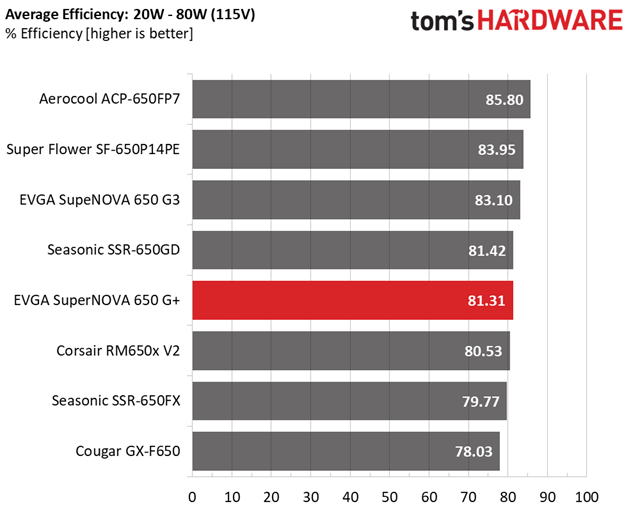
Under normal loads, the 650 G1+ was highly efficient. With light loads, its efficiency levels were good as well.
Efficiency At Low Loads
In the following tests, we measure the 650 G1+'s efficiency at loads significantly lower than 10 percent of its maximum capacity (the lowest load the 80 PLUS standard measures). The loads we dial are 20, 40, 60, and 80W. This is important for representing when a PC is idle, with power-saving features turned on.
| Test # | 12V | 5V | 3.3V | 5VSB | DC/AC (Watts) | Efficiency | Fan Speed | PSU Noise | PF/AC Volts |
|---|---|---|---|---|---|---|---|---|---|
| 1 | 1.192A | 0.502A | 0.481A | 0.202A | 19.499 | 69.824% | 795 RPM | 18.3 dB(A) | 0.812 |
| 12.085V | 4.965V | 3.326V | 4.960V | 27.926 | 115.35V | ||||
| 2 | 2.451A | 1.007A | 0.991A | 0.404A | 39.912 | 81.750% | 795 RPM | 18.3 dB(A) | 0.881 |
| 12.084V | 4.963V | 3.325V | 4.955V | 48.822 | 115.33V | ||||
| 3 | 3.642A | 1.510A | 1.472A | 4.950A | 59.395 | 85.826% | 795 RPM | 18.3 dB(A) | 0.886 |
| 12.084V | 4.962V | 3.324V | 4.950V | 69.204 | 115.31V | ||||
| 4 | 4.900A | 2.016A | 1.983A | 0.809A | 79.796 | 87.850% | 795 RPM | 18.3 dB(A) | 0.906 |
| 12.082V | 4.961V | 3.324V | 4.945V | 90.832 | 115.28V |
With 20W load, the 650 G1+ was just a hair away from 70% efficiency. It easily passed 80% in the three remaining tests, though. The PSU's noise remained low through those benchmarks, so the lack of a semi-passive mode went unnoticed.
5VSB Efficiency
The ATX specification (revision 1.4), along with CEC, ErP Lot 3 2014 and ErP Lot 6 2010/2013, states that 5VSB standby supply efficiency should be as high as possible, recommending 75 percent or higher with 550mA, 1A, and 1.5A of load. The PSU should also achieve higher than 75% efficiency at 5VSB under full load, or with 3A if its max current output on this rail is higher than 3A.
We take six measurements: one each at 100, 250, 550, 1000, and 1500mA, and one with the full load the 5VSB rail can handle.
Get Tom's Hardware's best news and in-depth reviews, straight to your inbox.
| Test # | 5VSB | DC/AC (Watts) | Efficiency | PF/AC Volts |
|---|---|---|---|---|
| 1 | 0.100A | 0.505 | 68.336% | 0.059 |
| 5.044V | 0.739 | 115.37V | ||
| 2 | 0.250A | 1.261 | 76.332% | 0.125 |
| 5.040V | 1.652 | 115.37V | ||
| 3 | 0.550A | 2.769 | 78.956% | 0.227 |
| 5.033V | 3.507 | 115.37V | ||
| 4 | 1.000A | 5.024 | 78.932% | 0.317 |
| 5.022V | 6.365 | 115.38V | ||
| 5 | 1.500A | 7.518 | 80.605% | 0.367 |
| 5.011V | 9.327 | 115.36V | ||
| 6 | 3.001A | 14.928 | 79.595% | 0.437 |
| 4.975V | 18.755 | 115.35V |

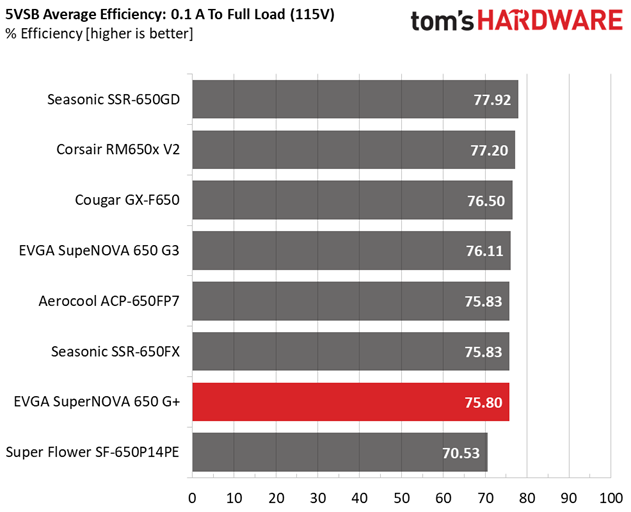
FSP usually equips its platforms with efficient 5VSB rails. We were satisfied by the 650 G1+'s performance in this discipline, though it would have been nice to see similar efficiency levels as the Hydro G units.
Power Consumption In Idle And Standby
In the table below, you'll find the power consumption and voltage values of all rails (except -12V) when the PSU is idle (powered on, but without any load on its rails), and the power consumption when the PSU is in standby mode (without any load, at 5VSB).
| Mode | 12V | 5V | 3.3V | 5VSB | Watts | PF/AC Volts |
|---|---|---|---|---|---|---|
| Idle | 12.082V | 4.968V | 3.328V | 4.968V | 8.627 | 0.415 |
| 115.4V | ||||||
| Standby | 0.143 | 0.011 | ||||
| 115.4V |

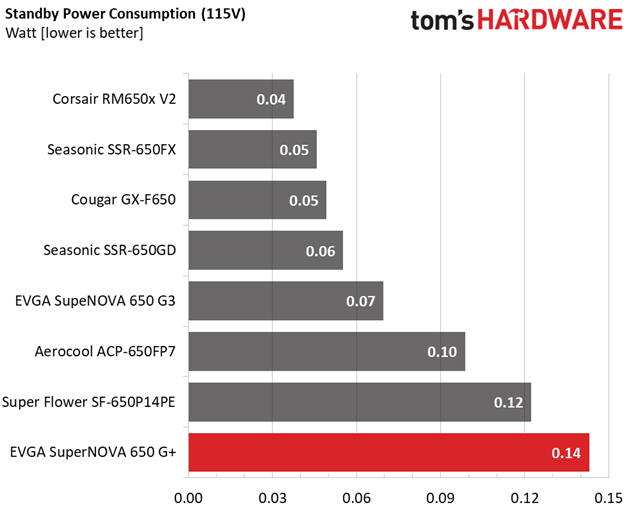
Power consumption during standby was higher than expected, especially with 230V input.
Fan RPM, Delta Temperature, And Output Noise
Our mixed noise testing is described in detail here.
The first chart below illustrates the cooling fan's speed (in RPM), and the delta between input and output temperature. The results were obtained at 37°C (98.6°F) to 47°C (116.6°F) ambient temperature.
The next chart shows the cooling fan's speed (again, in RPM) and output noise. We measure acoustics from one meter away, inside a hemi-anechoic chamber. Background noise inside the chamber is below 6 dB(A) during testing (it's actually much lower, but our sound meter’s microphone hits its floor), and the results are obtained with the PSU operating at 37°C (98.6°F) to 47°C (116.6°F) ambient temperature.
The following graph illustrates the fan's output noise over the PSU's operating range. The same conditions of the above graph apply to our measurements, though the ambient temperature is between 30°C (86°F) to 32°C (89.6°F).
The fan profile was super-relaxed up until ~410W load. However, it started to get more aggressive once the load exceeded 430W.
Regardless, this is not a noisy PSU. On the contrary, it performed quite well in this discipline, especially compared to competing models with similar 80 PLUS ratings.
MORE: Best Power Supplies
MORE: How We Test Power Supplies
MORE: All Power Supply Content
Current page: Efficiency, Temperature & Noise
Prev Page Load Regulation, Hold-Up Time & Inrush Current Next Page Protection Features & DC Power Sequencing
Aris Mpitziopoulos is a contributing editor at Tom's Hardware, covering PSUs.
-
WINTERLORD i read all your guys articles weather im in the market for new or not and i read that article and almost right off the top the article was killed with oh you can get the g3 for same price hah anyways guess if you hadnt someone woulda been quick to mentionReply -
dunn.md Your review is based on the $110 MSRP. This PSU is currently selling for $69.99 on Amazon. Would you highly recommend this PSU at this significantly lower price point?Reply -
DSzymborski The EVGA G3 650W can be bought for $69.99 also and it's much preferable.Reply
Like about 2/3 of the 850 or so individual PSUs EVGA is selling, I can't figure out exactly who the target market is for this. -
HERETIC-1 Calling this G1 "SUPERNOVA" is a bit on the nose.Reply
These are manufactured by FSP.
EVGA's excellent G2 and G3 SUPERNOVA's are manufactured by SUPERFLOWER.... -
Melon_seed Thank you for the review. I shall drop this off my list. Now its either Superflower leadex II or if I am lucky, Seasonic focus plus.Reply
